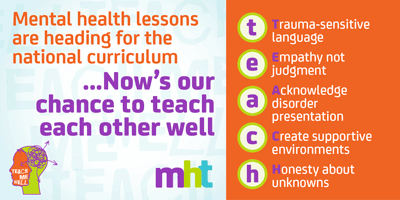New York State as a model for a mandatory mental health curriculum

As of July 2018, the education law in New York State became effective to include mental health in the curriculum. This came after a five year battle by the non-profit organisation Mental Health Association in New York State who campaigned for this legislative change.
Safety is at the core of a trauma-sensitive school. When helping children to feel safe, language is so important: and feeling safe is conducive to effective learning.
The bill
Whilst a mandatory health education bill was first approved forty years ago, this is the first time that mental health specifically is included. Sate legislation has changed over the years to include content about public health concerns: the effects of alcohol, drugs, smoking, detection and prevention of particular cancers.
The inclusion of mental health brings legislation up-to-date with our current understanding of health as being more than merely physical. The bill quotes the World Health Organisation’s definition of health as “a state of complete physical, mental and social well-being and not merely the absence of disease or infirmity”, suggesting the state favours a holistic view.
The amended bill does not mandate the curriculum, leaving it up to schools to decide how they incorporate the topic of mental health into health classes. However, the New York State Education Department provides materials to be used in conjunction with current guidance about the health education curriculum. Teachers, students, parents/guardians, and community partners are directed to a number of resources, and the Mental Health Association in New York State established a free resource and training centre in response to the adapted legislation.
The framework suggested by the New York State Education Department is for pupils aged four to eighteen. Information is adapted to make it age appropriate, and it is supported by non age-specific commentary. Here are some of their key suggestions:
A traumagenic approach
An understanding of the profound effects of trauma on a young person’s mental health underpins the suggested curriculum in New York State. The New York State Education Department is a proponent that a full definition of mental health acknowledges the effects of Adverse Childhood Experiences (ACEs); ACEs include - but are not limited to - physical, sexual, and emotional abuse, physical and emotional neglect, domestic violence, parental incarceration, substance misuse within the household, and familial mental illness.
Becoming a trauma-sensitive school is encouraged by the New York State Education Department. To be trauma-sensitive is to create an environment that enables all children to thrive. Importantly, it is reiterated that children who have experienced trauma will likely struggle in school, be it academically, socially, or behaviourally. This encourages teachers not to dismiss children who display challenging behaviour or fail to excel academically.
Safety is at the core of a trauma-sensitive school. When helping children to feel safe, language is so important: and feeling safe is conducive to effective learning. The New York State Education Department guidelines recommend teaching children about the importance of language, tone, and body language. This encourages open communication founded upon a mutual understanding of empathising - not judging - others.
The importance of healthy relationships
The New York State Education Department framework puts emphasis on the role of developing healthy relationships in promoting mental health. The subtleties of communication are acknowledged: from tone to body language... even the importance of silence is drawn attention to. Healthy communication skills facilitates respect towards the lived experience of others.
Developing skills to utilise personal and community resources is an integral part of the framework. Starting from a young age, children should be taught about the merits of sharing their subjective experiences with others. This evolves into discussion surrounding the warning signs, risk factors, and protective factors for a number of common mental illnesses. Because it is only the inclusion of mental health on the curriculum that is mandatory, not the content, educators can in theory choose which disorders they discuss. The New York State Education Department explicitly lists depression, anxiety, eating disorders, suicide, and from age fourteen, psychosis. Importantly, educators in New York State are encouraged to emphasise factors that aid recovery in a bid to reduce the stigma that comes with pathologising behaviour, thoughts, feelings, and experiences.
Self-care is more than bath bombs and walks
When discussing the place of self-care in mental health, many fall into the trap of suggesting that taking a hot bath is an adequate substitute for therapy. The New York State Educational Department discusses self-care with nuance by recognising it for what it is: something that cannot heal the effects of childhood trauma on its own, yet can promote personal responsibility for overall wellbeing. This part of the framework suggests that self-care does not operate alone but alongside other factors that affect wellbeing, such as home environment, genes, and influence of peers. Conceptualising self-care in this way empowers the individual to be mindful about whether their actions are genuinely in their best interest, encouraging self-awareness that can inform behaviour.
Resilience means using past experience to inform future behaviour
Similarly, the resilience narrative around mental health can, at times, seem to assign blame to the individual for their suffering, but this framework navigates it with sensitivity. Resilience is posited by the New York State Education Department as something more complex than being able to "bounce back" from adversity. Rather, resilience is the understanding that we can use past experiences to inform future behaviour, and that our self-esteem is influenced by both our own behaviour as well as external factors. This framework specifies that it is not experiencing difficulties unsupported that will make a young person more resilient, but it is the coping strategies that they are taught and acquire. The supportive environment that schools in New York State should aim to foster is what turns mere adversity into a situation from which one can learn and grow from.
- See more: The resilience narrative obscures the wider causes and solutions for children's mental health
- See more: Council to apologise for not offering young person with anxiety alternative educational arrangements
What Mental Health Today would like to see
The guidance given to schools in New York State encourages educators to create a curriculum that embodies many of the key principles of Mental Health Today’s "Teach Me Well" campaign:

Whilst the New York State Education Department's call for a holistic, trauma-sensitive approach is extremely positive, there is still room for a mental health curriculum to be expanded and adapted.
In particular, Mental Health Today is calling for honesty about unknowns. Given that New York State schools are being encouraged to teach young people about the disorders framework, it is appropriate and relevant to discuss the issues, debates, and unknowns in the health psychology field. Although their approach focuses particularly on a traumagenic model of poor mental health, they posit mental wellbeing as something that can be affected by every area in one's life: peers, genes, home environment, self-esteem, brain chemistry, and school environment.
If educators strive to create an environment founded upon mutual support and openness, then transparency concerning unknowns is so important. What's more, acknowledging unknowns destabilises the power dynamic between children and mental health/educational professionals, encouraging young people to question received dogma. Surely facilitating discussions rather than one-sided lectures should be embraced.
It's encouraging to see many of our recommendations reflected in guidelines that are already in practice - but let's not be complacent.
Read more about MHT's "Teach Me Well" campaign here
New York State Education Department recommendations/resources
* For more information about trauma-sensitive schools
How does this story make you feel? Share your views by commenting below, or join the conversation on Twitter at 12pm UK time on Wednesday 9 January using #MHTchat.
Comments
Write a Comment
Comment Submitted